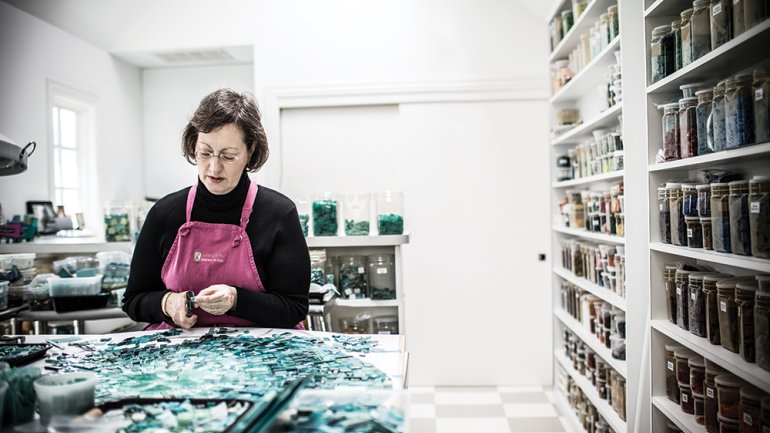Souvenirs of a Journey
Souvenirs of a Journey
When Sonia King got the news in late 2011 that her mosaic Depthfinder had been acquired by the Museo d’Arte della Città di Ravenna for its permanent collection, she was ecstatic. “It is a huge deal for me,” says King, the first American to be included in the Italian museum’s world-class contemporary mosaic collection. “It’s also a huge deal for the art of mosaic in the U.S.”
The ancient city of Ravenna is considered the international hub for mosaics. And while the art mosaic tradition in the United States trails that of Europe, Sonia King is leading the charge to catch up, as an award-winning artist and a founding member of the Society of American Mosaic Artists. “We started out in 2000 with 75 members, and it’s grown to 1,000,” she says. Her beautifully illustrated book, Mosaic Techniques and Traditions, published in 2003 and still selling strong, has also helped raise the profile of mosaic art.
When she graduated with a degree in environmental design from California College of Arts and Crafts (now CCA) in 1975, King dreamed of designing public spaces in airports. “I had painted and sculpted in school,” the Dallas-based artist explains, “but I never really found my medium.” She did find her way into the business world, and when she took a job as a marketing consultant for a major oil company, she was encouraged to get an MBA to earn a better day rate. She entered Southern Methodist University’s MBA program in the mid-1990s but soon found her creative juices at a low ebb. “At some point I was, like, ‘Must make art now!’ ” she remembers. “I thought I would die if I had to read another Harvard Business Review – I had to do something artistic.”
“I don’t know what made me decide to make a mosaic,” she says. But there were nudges. Her job required her to travel regularly to Europe, where she was exposed to a number of mosaic masters. And she had fond childhood memories of pushing tiles around with her mother, who took mosaic classes at the Dallas Museum of Art with sculptors Octavio Medellín and Heri Bartscht.
So perhaps it was no surprise that, after several years in the business world, King “dragged out Mother’s old stuff” and went to work. “I was probably a third of the way through the first mosaic I had done since childhood and I was, like, ‘I’m doing this the rest of my life,’ ” she says.
She completed her MBA in 1996, quit her day job, and started taking commissions for her mosaic work. Within the first year, she was exhibiting and selling her work. “I’m really interested in what I discover each time I cut and place a piece,” she says. Her commissions, such as Nebula Chroma for Children’s Medical Center of Dallas, typically require four to six months to produce with the help of a part-time assistant.
Today, her emphasis is less on commissions and more on making individual pieces of art (about 1 to 2 feet by 2 to 3 feet) that hang flat on a wall, like a painting. The work is very labor-intensive, each piece requiring six to eight weeks. “My challenge is that I want the work to look serene,” she explains. “I want all those disparate little pieces, the tesserae, to play nice together, to support each other, and make them more than what they are individually.”
Unlike many mosaic artists, King prefers to work without grout; “I like what happens between the pieces. I like the shadows. I want to know what’s happening in those spaces,” she says. Color, scale, spacing, texture, and reflectivity are variables that all come into play. Within each work, she juxtaposes diverse materials that she finds in places on and off the beaten path – from treasures at the Tucson gem show to broken glass in parking lots.
“For me, mosaic is the process of picking up one piece and putting it down and choosing the piece that goes next to it,” King says. “The actual mosaic is a souvenir of the journey.”
Coded Messages, the series she’s currently working on, is a departure from her previous work. “I’m trying to reduce mosaic down to a simple hand-formed cement substrate and tesserae that have the appearance of movable type,” she says. She tries to keep the adhesion invisible “so it looks like you could move the tesserae,” she says, “but they’re actually stuck.”
King sells almost everything she makes, even though she has never had gallery representation. “Don’t discount the value of a good website,” she says. “It’s quite stunning to me how many people will never speak to me on the phone but will send me checks for thousands and thousands of dollars and ask ‘When can you ship it?’”
That said, you won’t find prices or “Buy It Now” buttons on her website; “I want [people] to email me and start a dialogue about the work,” she explains. “Buyers usually want to feel a connection to a piece if they’re going to write a check with zeros on the end.”
Prices for her individual pieces range from $15,000 to $25,000, depending on the types of material, the complexity of the design, and the size of the piece. Wall installations, such as Nebula Aqua, which recently won special recognition in the international Mosaic and Architecture Prize competition, are in the $100,000 range.
“I think we’re living in sort of a golden age of mosaic,” she says. “There’s a real acknowledgment that it is a fine-art medium.” And Sonia King is in the forefront of making sure the resurgence continues.
Christina Patoski is a journalist and photographer who lives in Fort Worth, Texas.




